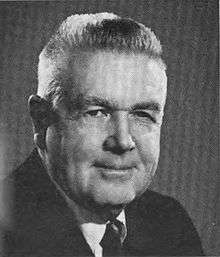James J. Delaney
| James J. Delaney | |
|---|---|
 | |
| Member of the U.S. House of Representatives from New York's 9th district | |
|
In office January 3, 1963 – December 31, 1978 | |
| Preceded by | Eugene J. Keogh |
| Succeeded by | Geraldine Ferraro |
| Member of the U.S. House of Representatives from New York's 7th district | |
|
In office January 3, 1953 – January 3, 1963 | |
| Preceded by | Louis B. Heller |
| Succeeded by | Joseph P. Addabbo |
| Member of the U.S. House of Representatives from New York's 6th district | |
|
In office January 3, 1949 – January 3, 1953 | |
| Preceded by | Robert J. Nodar, Jr. |
| Succeeded by | Lester Holtzman |
|
In office January 3, 1945 – January 3, 1947 | |
| Preceded by | Andrew L. Somers |
| Succeeded by | Robert J. Nodar, Jr. |
| Personal details | |
| Born |
James Joseph Delaney March 19, 1901 New York City, New York, U.S. |
| Died |
May 24, 1987 (aged 86) Key Biscayne, Florida, U.S. |
| Political party | Democratic |
James Joseph Delaney (March 19, 1901 – May 24, 1987) was a Representative from New York.
Delaney was born in New York City on March 19, 1901. He attended the public schools in Long Island City, Queens. He graduated from the law department of St. John’s College, Brooklyn, N.Y. LL.B., 1931; was admitted to the bar in 1933 and commenced practice in New York City. He served as assistant district attorney of Queens County from 1936 to 1944.
Career in Congress
Delaney was elected as a Democrat to the 79th Congress (January 3, 1945 – January 3, 1947). He was an unsuccessful candidate for reelection in 1946 to the Eightieth Congress. He resumed the practice of law in New York City, until being elected to the 81st United States Congress on January 3, 1949, where he served fourteen terms.
During the late 1950s, after a series of lurid magazine articles and Hollywood films helped to sensationalize youth gangs and violence, Delaney was one of the first congressmen to author legislation banning automatic-opening or switchblade knives in 1954. On April 17, 1958, Delaney stated, "Every day our newspapers report numerous muggings and attacks, most of them involving knives. Can we sit by complacently and ignore the bloodshed in our streets?"[1][2][3] The ban on switchblade knives was eventually enacted into law as the Switchblade Knife Act of 1958.[3] Rep. Delaney and other congressmen supporting the Switchblade Knife Act believed that by stopping the importation and interstate sales of automatic knives (effectively halting sales of new switchblades), the law would reduce youth gang violence by blocking access to what had become a symbolic weapon.[1][3][4] However, while switchblade imports, domestic production, and sales to lawful owners soon ended, later legislative research demonstrated that youth gang violence rates had in fact rapidly increased, as gang members turned to firearms instead of knives.[5]
Delaney later became chairman of a Select Committee to conduct an investigation and study of the use of chemicals, pesticides, and insecticides in and with respect to food products (81st and 82nd Congresses). He was noted for adding the 1958 Delaney clause to the 1938 Federal Food, Drug, and Cosmetic Act to ban carcinogens as food additives, Committee on Rules (95th Congress). Delaney resigned at the end of his term December 31, 1978, and was not a candidate for reelection to the 96th Congress.
Later life
Delaney was a resident of Key Biscayne, Florida, until his death in Tenafly, New Jersey on May 24, 1987. He was interred in Calvary Cemetery in Queens.
Notes
- 1 2 Levine, Bernard R., The Switchblade Menace, OKCA Newsletter (1993)
- ↑ Knife World (August 1990)
- 1 2 3 Switchblade Knives: Hearing, House Committee on Interstate and Foreign Commerce, Eighty-fifth Congress, Minutes of the Second Session, April 17, 1958
- ↑ Knife World Magazine (August 1990)
- ↑ Clark, Charles S., Youth Gangs Worsening Violence Prompts Crackdowns and Community Mobilization, Congressional Quarterly 1, 11 October 1991, pp. 753-776
References
- United States Congress. "James J. Delaney (id: D000211)". Biographical Directory of the United States Congress.
| United States House of Representatives | ||
|---|---|---|
| Preceded by Andrew L. Somers |
Member of the U.S. House of Representatives from New York's 6th congressional district 1945–1947 |
Succeeded by Robert Nodar, Jr. |
| Preceded by Robert Nodar, Jr. |
Member of the U.S. House of Representatives from New York's 6th congressional district 1949–1953 |
Succeeded by Lester Holtzman |
| Preceded by Louis B. Heller |
Member of the U.S. House of Representatives from New York's 7th congressional district 1953–1963 |
Succeeded by Joseph P. Addabbo |
| Preceded by Eugene J. Keogh |
Member of the U.S. House of Representatives from New York's 9th congressional district 1963–1978 |
Succeeded by Geraldine Ferraro |
| Political offices | ||
| Preceded by Ray Madden Indiana |
Chairman of House Rules Committee 1977–1978 |
Succeeded by Claude D. Pepper Florida |
